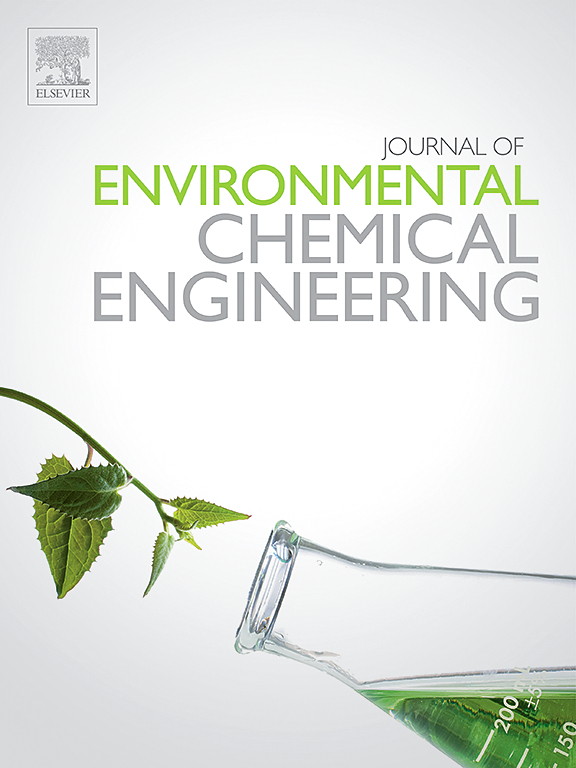富电子烷基取代亚酞菁h12subpc - ph- tbu与钴掺杂对增强光催化性能的协同作用
IF 7.4
2区 工程技术
Q1 ENGINEERING, CHEMICAL
引用次数: 0
摘要
构建s型异质结是通过促进电荷转移和获得更高的氧化还原电位来提高光催化效率的有效方法。本文合成了一种新的轴向取代的亚酞菁衍生物h12subpc - ph- tbu (SubPc-tBu),并通过超分子自组装组装到钴掺杂的ZnS (Co-ZnS)上,形成了独特的S-scheme异质结(SubPc-tBu/Co-ZnS)。在该体系中,富电子的SubPc-tBu单元与加入的钴(Co)一起,在促进电荷转移和提高异质结的光催化效率方面起着关键作用。该光催化剂在30 min内对呋喃醌(FT)的降解效率达到97 %,表观速率常数比ZnS高17.24倍,比SubPc-tBu高10.35倍,表现出优异的光催化性能。在连续5次循环后,其降解效率仍保持在83.36 %,具有良好的稳定性和可回收性。实验和理论研究表明,光催化活性的增强是由于界面电荷转移机制改善了载流子的分离和转移。时间依赖密度泛函理论(TDDFT)和LC-MS耦合DFT阐明了电子转移途径和污染物降解机制,为环境污染解决方案的光催化剂设计提供了见解。本文章由计算机程序翻译,如有差异,请以英文原文为准。
Synergistic effect of electron-rich alkyl-substituted subphthalocyanine H12SubPc-Oph-tBu and cobalt-doping for enhanced photocatalytic performance
Constructing S-scheme heterojunctions serves as a potent approach to boost photocatalytic efficiency by promoting charge transfer and attaining elevated redox potentials. Herein, a novel axially substituted subphthalocyanine derivative, H12SubPc-Oph-tBu (SubPc-tBu), was synthesized and assembled onto cobalt-doped ZnS (Co-ZnS) via supramolecular self-assembly to form a unique S-scheme heterojunction (SubPc-tBu/Co-ZnS). In this system, the electron-rich SubPc-tBu unit, in conjunction with the incorporated cobalt (Co), is pivotal in promoting charge transfer and enhancing the photocatalytic efficiency of the heterojunction. The photocatalyst achieved a 97 % degradation efficiency of furantoin (FT) within 30 minutes, with an apparent rate constant that is 17.24 times higher than ZnS and 10.35 times greater than SubPc-tBu, demonstrating its superior photocatalytic performance. Furthermore, after five consecutive cycles, it retained a degradation efficiency of 83.36 %, highlighting its excellent stability and recyclability. Experimental and theoretical studies revealed that the enhanced photocatalytic activity arises from an interfacial charge transfer mechanism improving carrier separation and transfer. Time-dependent density functional theory (TDDFT) and LC-MS coupled with DFT elucidated electron transfer pathways and pollutant degradation mechanisms, offering insights into photocatalyst design for environmental pollution solutions.
求助全文
通过发布文献求助,成功后即可免费获取论文全文。
去求助
来源期刊

Journal of Environmental Chemical Engineering
Environmental Science-Pollution
CiteScore
11.40
自引率
6.50%
发文量
2017
审稿时长
27 days
期刊介绍:
The Journal of Environmental Chemical Engineering (JECE) serves as a platform for the dissemination of original and innovative research focusing on the advancement of environmentally-friendly, sustainable technologies. JECE emphasizes the transition towards a carbon-neutral circular economy and a self-sufficient bio-based economy. Topics covered include soil, water, wastewater, and air decontamination; pollution monitoring, prevention, and control; advanced analytics, sensors, impact and risk assessment methodologies in environmental chemical engineering; resource recovery (water, nutrients, materials, energy); industrial ecology; valorization of waste streams; waste management (including e-waste); climate-water-energy-food nexus; novel materials for environmental, chemical, and energy applications; sustainability and environmental safety; water digitalization, water data science, and machine learning; process integration and intensification; recent developments in green chemistry for synthesis, catalysis, and energy; and original research on contaminants of emerging concern, persistent chemicals, and priority substances, including microplastics, nanoplastics, nanomaterials, micropollutants, antimicrobial resistance genes, and emerging pathogens (viruses, bacteria, parasites) of environmental significance.
 求助内容:
求助内容: 应助结果提醒方式:
应助结果提醒方式:


